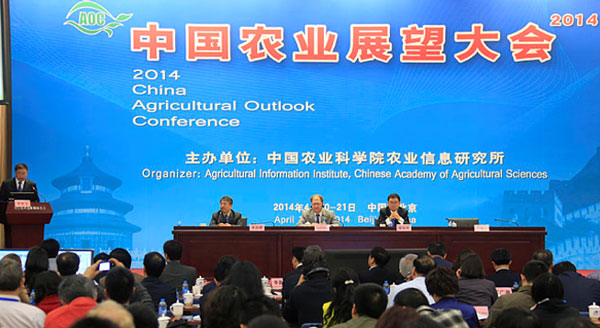
The 2014 China
Agriculture Outlook Conference was held in Beijing on April, 20. The Conference
was hosted by the Agricultural Information Institute (AII) of Chinese Academy of
Agricultural Sciences (CAAS).
At the Conference,
Xu Shiwei, AII Director General, released the China Agriculture Outlook Report
(2014-2023), the first of its kind in China, along with sub-reports covering
major agricultural products including grain, cotton, oil seeds, sugar, meat,
poultry, eggs, dairy products, vegetables and fruits. The Report reflects
achievements made by China's agriculture monitoring and early-warning system,
and opens a new chapter in China's efforts to forecast market trends to provide
guidance to markets and take the initiative to react to changes in international
markets.
According to the
Report, in the next decade, new-type operation system will instill more vitality
to agricultural production, and agricultural development patterns will continue
to transform mainly driven by and science and technology advancement. The Report
points out that agriculture in China will continue to enjoy a favorable policy
environment, and the application of IT technology will bring new opportunities
for agriculture. The Report also states that, meanwhile, China will face rising
production constraints due to scarcity of land and water resource and increasing
risks in production caused by climate change. Despite that the demand growth for
agricultural products will be slightly higher than production growth, the bowls
of the Chinese people will continue to be firmly set in their own hands.
The Report has made
predictions and forecasts about the production, demand and trade of major
agricultural products in China for the next decade:
General speaking,
production of major agricultural products will show a steady and upward trend in
the next decade. The output of rice, wheat, sugar and vegetables will increase
steadily. The output of aquatic products, beef, mutton, feed, maize, oil seeds,
poultry and eggs will grow rapidly. The dairy production will grow by an average
annual rate of 3.5%, the fastest among the products covered by the Report.
Strong growth will be seen in demand for major agricultural products with over
2% annual growth for aquatic products, milk, maize, sugar and fruits and
moderate growth for meat, wheat, rice, cotton and vegetables. China will
maintain a high level of self sufficiency in rice, wheat and maize, and achieve
the goal of general sufficiency in grains and absolute security of food grain.
Cooking oil production will increase steadily, leading to a decline in import.
Soybean import growth will slow down substantially with the annual import volume
expected to reach 73 million tons in 2023. Cotton production, as affected by
changing policies, will fall in terms of planting area and output while its
consumption will grow slowly. There will be robust growth in sugar consumption
while its production growth is expected to be mild, leading to a drop in
self-sufficiency level. The growth of meat production will fall slight behind
consumption growth, and the import is expected to rise. The demand of poultry,
eggs, vegetables and fruits for processing will grow rapidly, but the trade
balance of these products will remain in surplus. Aquatic production will
continue to increase due to development in aquaculture. Feed production is
expected to grow at an annual rate of 2.3% mainly due to growth in compound feed
production while feed consumption will also grow steadily.
The Report came to
the conclusion that agriculture in China will continue to provide fundamental
support to China's economic development, and China will make new contributions
to world food security and safety.
According to Mr. Xu
Shiwei, agricultural outlook work is a technical tool to predict future trends
in agricultural development by using current information. Its core is to release
supply and demand information and forecast market changes. It is a common
practice for International organizations and many nations to hold agriculture
outlook conferences and release outlook reports to provide information service
to agriculture, regulate agriclutlral market, and guide international
agricultural trade. In order to improve agricultural information monitoring and
early warning, Ministry of Agriculture has set up an expert committee composed
of analysts groups for 18 major agricultural products including grain, cotton,
cooking oil, meat, eggs, milk, vegetables and fruits. The Agricultural
Information Institute of CAAS, based on its years of research, has established
the China Agriculture Monitoring and Early-warning System, which is the
technical foundation for systematic monitoring and early-warning work.
Apart from the
Agricultural Information Institute, experts and researchers of a range of
institutes including the MOA Research Center for Rural Economy, MOA Information
Center and MOA Agricultural Trade Promotion Center have also contributed to the
China Agricultural Outlook Report (2014-2023), which reflects all major
achievements made by China in the area of agricultural outlook.